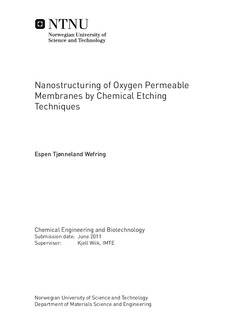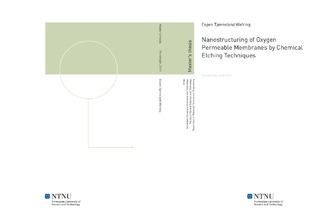| dc.contributor.advisor | Wiik, Kjell | nb_NO |
| dc.contributor.author | Wefring, Espen Tjønneland | nb_NO |
| dc.date.accessioned | 2014-12-19T13:21:38Z | |
| dc.date.available | 2014-12-19T13:21:38Z | |
| dc.date.created | 2012-06-21 | nb_NO |
| dc.date.issued | 2011 | nb_NO |
| dc.identifier | 564606 | nb_NO |
| dc.identifier | ntnudaim:6611 | nb_NO |
| dc.identifier.uri | http://hdl.handle.net/11250/247754 | |
| dc.description.abstract | Mixed ionic electronic conducting ceramic oxides are being investigated for use as membranes for oxygen separation from air and as electrodes in solid oxide fuel cells [1, 2]. Oxygen surface exchange rate is an important parameter controlling the oxy- gen permeation rate of these membranes [3]. In this work surface structuring by wet chemical etching is investigated as a possible route to improve the surface exchange rate of La0.2Sr0.8Fe0.8Ta0.2O3−δ (LSFT). Several different etchant solutions have been in- vestigated (HCl, HNO3, H2SO4, H2C2O4, NaHCO3, Na2CO3 and KOH) and evaluated with respect to etch rate, the resulting surface morphology, selectivity and special effects caused by the etchant or the nature of the sample being etched. The resulting surface structure after etching proved to be very dependent on microstructure, showing both el- evated grain boundary and mid grain etching. The mid grain etching was unexpected, and additional experiments were done to investigate the cause of this behaviour. The effect of surface structuring using wet chemical etching was investigated using electri- cal conductivity relaxation at 800◦C and 900◦C. This showed that an increase of the specific surface area 3.6 times gave an increase of the chemical surface exchange coef- ficient about 3.16 times at 800◦C. The influence of temperature and partial pressure of oxygen on the effect of surface structuring is discussed based on the obtained results. LSF-based membranes (La1−xSrxFe1−yMyO3−δ where M = transition metal cation) show limited stability towards CO2 containing atmospheres, forming surface layers of SrCO3 [4, 5]. It is suggested that a subsequent removal of this layer by i.e. chemical etching could lead to a fine surface structuring. In this work, exposure of LSFT-samples to CO2- rich atmospheres was done at 900◦C and 1000◦C without the formation of such a layer. Reasons for this are discussed and alternate experimental conditions are suggested. | nb_NO |
| dc.language | eng | nb_NO |
| dc.publisher | Institutt for materialteknologi | nb_NO |
| dc.subject | ntnudaim:6611 | no_NO |
| dc.subject | MTKJ Industriell kjemi og bioteknologi | no_NO |
| dc.subject | Materialutvikling og -bruk | no_NO |
| dc.title | Nanostructuring of Oxygen Permeable Membranes by Chemical Etching Techniques | nb_NO |
| dc.type | Master thesis | nb_NO |
| dc.source.pagenumber | 107 | nb_NO |
| dc.contributor.department | Norges teknisk-naturvitenskapelige universitet, Fakultet for naturvitenskap og teknologi, Institutt for kjemi | nb_NO |

